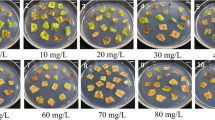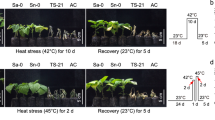Abstract
Coloration of plant organs is governed by a combination of MYB- and bHLH-type transcription factors (TFs) and WD repeats or WD40 proteins in a MYB-bHLH-WDR (MBW) ternary protein complex for anthocyanin synthesis. Here, the MYB-type gene Rosea1 (ROS1) and the bHLH-type gene Delila (DEL) from Antirrhinum majus were expressed separately or simultaneously in Arabidopsis and Brassica napus to determine the influence on anthocyanin biosynthesis in different plant species. Overexpression of ROS1 alone substantially improved anthocyanin production in the leaves and seeds in Arabidopsis and triggered the transcription of late biosynthetic genes, such as AtDFR and AtANS. However, overexpression of DEL alone in Arabidopsis failed to produce any anthocyanin in the whole plants. Interestingly, DEL and ROS1 co-expression strengthened the anthocyanins biosynthesis and modified petal color from white into purple in Arabidopsis. The anthocyanidin content was consistent with the organ coloration in Arabidopsis. The main anthocyanin compounds in transgenic ROS1 leaves were cyanidin 3,5-O-diglucoside (28.0 µg/g DW) and cyanidin 3-O-glucoside (17.5 µg/g DW). In flowers of DEL and ROS1 co-expressed transgenic Arabidopsis, the dominating anthocyanin compounds were delphinidin 3-O-glucoside (33.8 µg/g DW), cyanidin 3,5-O-diglucoside (20.1 µg/g DW), and cyanidin 3-O-glucoside (10.5 µg/g DW). However in B. napus, neither separate nor co-expression of DEL and ROS1 produced any organ coloration. Most of the early and the late biosynthetic genes had no significant induction in the transgenic B. napus.




Similar content being viewed by others
References
Albert NW, Lewis DH, Zhang H, Schwinn KE, Jameson PE, Davies KM (2011) Members of an R2R3-MYB transcription factor family in Petunia are developmentally and environmentally regulated to control complex floral and vegetative pigmentation patterning. Plant J 65:771–784
Borevitz JO, Xia YJ, Blount J, Dixon RA, Lamb C (2000) Activation tagging identifies a conserved MYB regulator of phenylpropanoid biosynthesis. Plant Cell 12:2383–2393
Bovy A, De Vos R, Kemper M et al (2002) High-flavonol tomatoes resulting from the heterologous expression of the maize transcription factor genes LC and C1. Plant Cell 14:2509–2526
Butelli E, Titta L, Giorgio M et al (2008) Enrichment of tomato fruit with health-promoting anthocyanins by expression of select transcription factors. Nat Biotechnol 26:1301–1308
Cao H, Ji Y, Li SC et al (2019) Extensive metabolic profiles of leaves and stems from the medicinal plant Dendrobium officinale Kimura et Migo. Metabolites 9
Cardoza V, Stewart CN (2003) Increased Agrobacterium-mediated transformation and rooting efficiencies in canola (Brassica napus L.) from hypocotyl segment explants. Plant Cell Rep 21:599–604
Chalhoub B, Denoeud F, Liu S et al (2014) Plant genetics. Early allopolyploid evolution in the post-Neolithic Brassica napus oilseed genome. Science 345:950–953
Chen BY, Heneen WK (1990) Independent inheritance of flower color and male-fertility restorer characters in Brassica-Napus L. Plant Breed 104:81–84
Chu H, Jeong JC, Kim WJ et al (2013) Expression of the sweetpotato R2R3-type IbMYB1a gene induces anthocyanin accumulation in Arabidopsis. Physiol Plant 148:189–199
Cone KC, Burr FA, Burr B (1986) Molecular analysis of the maize anthocyanin regulatory locus C1. Proc Natl Acad Sci U S A 83:9631–9635
D’auria JC, Gershenzon J (2005) The secondary metabolism of Arabidopsis thaliana: growing like a weed. Curr Opin Plant Biol 8:308–316
Debeaujon I, Leon-Kloosterziel KM, Koornneef M (2000) Influence of the testa on seed dormancy, germination, and longevity in Arabidopsis. Plant Physiol 122:403–414
Fatihah HNN, Lopez DM, Van Arkel G, Schaart JG, Visser RGF, Krens FA (2019) The ROSEA1 and DELILA transcription factors control anthocyanin biosynthesis in Nicotiana benthamiana and Lilium flowers. Sci Hortic 243:327–337
Goncalves AC, Nunes AR, Falcao A, Alves G, Silva LR (2021) Dietary effects of anthocyanins in human health: a comprehensive review. Pharmaceuticals 14
Grotewold E, Drummond BJ, Bowen B, Peterson T (1994) The Myb-homologous P-gene controls phlobaphene pigmentation in maize floral organs by directly activating a flavonoid biosynthetic gene subset. Cell 76:543–553
Harborne JB, Williams CA (2000) Advances in flavonoid research since 1992. Phytochemistry 55:481–504
Hichri I, Barrieu F, Bogs J, Kappel C, Delrot S, Lauvergeat V (2011) Recent advances in the transcriptional regulation of the flavonoid biosynthetic pathway. J Exp Bot 62:2465–2483
Koes R, Verweij W, Quattrocchio F (2005) Flavonoids: a colorful model for the regulation and evolution of biochemical pathways. Trends Plant Sci 10:236–242
Lee HS, Wicker L (1991) Anthocyanin pigments in the skin of lychee fruit. J Food Sci 56:466–468
Lepiniec L, Debeaujon I, Routaboul JM et al (2006) Genetics and biochemistry of seed flavonoids. Annu Rev Plant Biol 57:405–430
Liu R, Lehane S, He X et al (2010) Characterisations of odorant-binding proteins in the tsetse fly Glossina morsitans morsitans. Cell Mol Life Sci 67:919–929
Mooney M, Desnos T, Harrison K, Jones J, Carpenter R, Coen E (1995) Altered regulation of tomato and tobacco pigmentation genes caused by the delila gene of Antirrhinum. Plant J 7:333–339
Naing AH, Ai TN, Lim KB, Lee IJ, Kim CK (2018) Overexpression of Rosea1 from snapdragon enhances anthocyanin accumulation and abiotic stress tolerance in transgenic tobacco. Front Plant Sci 9:1070
Naing AH, Park KI, Ai TN et al (2017) Overexpression of snapdragon Delila (Del) gene in tobacco enhances anthocyanin accumulation and abiotic stress tolerance. BMC Plant Biol 17:65
Nakatsuka T, Haruta KS, Pitaksutheepong C et al (2008) Identification and characterization of R2R3-MYB and bHLH transcription factors regulating anthocyanin biosynthesis in gentian flowers. Plant Cell Physiol 49:1818–1829
Pazares J, Ghosal D, Saedler H (1990) Molecular analysis of the C1-I allele from Zea-mays - a dominant mutant of the regulatory C1-locus. EMBO J 9:315–321
Sandoval-Ramirez BA, Catalan U, Llaurado E et al (2022) The health benefits of anthocyanins: an umbrella review of systematic reviews and meta-analyses of observational studies and controlled clinical trials. Nutr Rev 80:1515–1530
Schwinn K, Venail J, Shang Y et al (2006) A small family of MYB-regulatory genes controls floral pigmentation intensity and patterning in the genus Antirrhinum. Plant Cell 18:831–851
Schwinn KE, Boase MR, Bradley JM et al (2014) MYB and bHLH transcription factor transgenes increase anthocyanin pigmentation in petunia and lisianthus plants, and the petunia phenotypes are strongly enhanced under field conditions. Front Plant Sci 5
Sernyk JL, Stefansson BR (1982) White flower color in rape (Brassica-Napus) associated with a radish (Raphanus-Sativus) chromosome. Can J Genet Cytol 24:729–734
Sharma S, Holme IB, Dionisio G et al (2020) Cyanidin based anthocyanin biosynthesis in orange carrot is restored by expression of Am Rosea1 and Am Delila, MYB and bHLH transcription factors. Plant Mol Biol 103:443–456
Stafford HA (1998) Teosinte to maize - Some aspects of missing biochemical and physiological data concerning regulation of flavonoid pathways. Phytochemistry 49:285–293
Tanaka Y, Sasaki N, Ohmiya A (2008) Biosynthesis of plant pigments: anthocyanins, betalains and carotenoids. Plant J 54:733–749
Wang F, He J, Shi J et al (2016) Embryonal control of yellow seed coat locus ECY1 is related to alanine and phenylalanine metabolism in the seed embryo of Brassica napus. G3 (Bethesda) 6:1073–81
Weigel D, Glazebrook J (2006) In planta transformation of Arabidopsis. CSH Protoc 2006
Funding
This work was supported by the Natural Science Foundation of Zhejiang Province (CN) (no. LY19C130005) and the National Natural Science Foundation of China (no. 31571700).
Author information
Authors and Affiliations
Corresponding author
Ethics declarations
Conflict Interest
The authors declare no competing interests.
Additional information
Publisher's Note
Springer Nature remains neutral with regard to jurisdictional claims in published maps and institutional affiliations.
Supplementary Information
Below is the link to the electronic supplementary material.
Rights and permissions
Springer Nature or its licensor (e.g. a society or other partner) holds exclusive rights to this article under a publishing agreement with the author(s) or other rightsholder(s); author self-archiving of the accepted manuscript version of this article is solely governed by the terms of such publishing agreement and applicable law.
About this article
Cite this article
Wang, F., Zheng, T., Zhu, Y. et al. The ROSEA1 and DELILA Transcription Factors Modified Plant Organ Color in Arabidopsis but not in Brassica napus. Plant Mol Biol Rep 41, 185–193 (2023). https://doi.org/10.1007/s11105-022-01362-6
Received:
Accepted:
Published:
Issue Date:
DOI: https://doi.org/10.1007/s11105-022-01362-6




